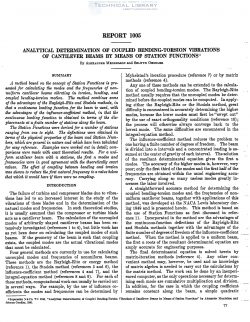naca-report-1005

- Version
- 164 Downloads
- 1.64 MB File Size
- 1 File Count
- September 1, 2016 Create Date
- September 1, 2016 Last Updated
National Advisory Committee for Aeronautics, Report - Analytical Determination of Coupled Bending Torsion Vibrations of Cantilever Beams by Means of Station Functions

A method based on the concept of Station Functions is pre-
sented for calculating the modes and the frequencies of non-
uniform cantilerer beams vibrating in torsion, bending, and
coupled bending-torsion motion. The method combines some
of the advantages of the Rayleigh-Ritz and Stodola methods, in
that a continuous loading fitnction for the beam is used, with
the admntages of the infiuence-coefiicient method, in that the
continuous loading function is obtained in terms of the dis-
placements at a finite number of stations along the beam.
The Station Functions were derired for a number of stations
ranging from one to eight. The deflections were obtained in
terms of the physical properties of the beam and Station Num-
bers, which are general in nature and which have been tabulated
for easy reference. Examples were worked out in detail; com-
parisons were made with exact theoretical results. For a uni-
form cantilever beam with n stations, the first n modes and
frequencies were in good agreement un'th the theoretically exact
values. The eject of coupling between bending and torsion
was shown to reduce the first natural frequency to a value below
that which it would hare if there were no coupling.
The failure of turbine and compressor blades due to vibra-
tions has led to an increased interest in the study of the
vibrations of these blades and in the determination of the
natural modes and frequencies. In such theoretical studies,
it is usually assumed that the compressor or turbine blade
acts as a. cantilever beam. The calculation of the uncoupled
modes of arbitrarily shaped cantilever beams has been ex-
tensively investigated (references 1 to 4), but little work has
as yet been done on calculating the coupled modes of such
beams. If the geometry of the beam is such that coupling
exists, the coupled modes are the actual vibrational modes
that must be calculated.
| File | Action |
|---|---|
| naca-report-1005 Analytical Determination of Coupled Bending Torsion Vibrations of Cantilever Beams by Means of Station Functions.pdf | Download |

Comment On This Post